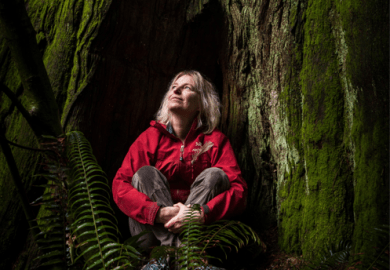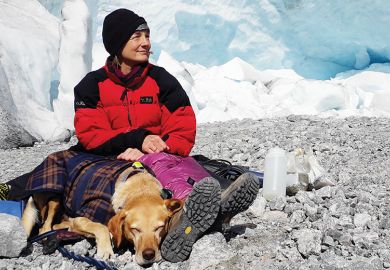The aim of this Nobel Symposium, Early Life On Earth, was to stimulate discussion on those most fascinating of questions: the what, how and why of early evolution. To this end, some 44 chemists, geologists, palontologists and biologists from 12 countries were drawn together by Stefan Bengtson for a week's debate in the secluded setting of Nobel's old manor house, at Karlskoga in Sweden.
No book on evolutionary sciences is complete these days, it seems, without a foreword by Stephen Jay Gould and this book is, of course, no exception. Gould provides us with a typically baroque overture for this Swedish house party, expounding widely on the themes of historical science. The reader expects to be amused and diverted, and Gould obliges by ornamenting the path of the reader with unexpected brambles and colourful beetles: the thoughts of obscure and extinct philosophers; absurdly pompous, sepia-tinted quotes from Macaulay, and portentous fragments of psalms all too distantly remembered on this side of the Atlantic.
Gould argues, of course, along a well-trodden Gouldian theme. Science, he suggests, is informed not only by timeless generalisations (as in the "pure" sciences of physics and chemistry) but also by the time-specific and directional phenomena revealed by the historically bound disciplines of astronomy and geology. But as Gould himself observes, the subsequent papers must cover a very large expanse of ground, and one must share with him a certain apprehension at a perceived lack of cohesion between the various contributing disciplines. One of the aims of such a symposium must be to bring together the disparate strands of geology, biochemistry, biology and palobiology. Each of these disciplines should then be made accessible to a more general scientific readership. To our frustration, we learn in the preface that "lectures stimulated questions, questions led to answers that generated more questions, and the sessions typically continued into discussions in large and small groups in the halls of the Nobel manor". In the time of Darwin, such discussions and syntheses would no doubt have been published as "Proceedings", acrimonious invective and all. Regrettably, we learn nothing of these discussions from the present volume.
The bulk of the book is divided into three main historical themes: life's gestation and infancy during the Archaean Eon (before 2.5 billion years ago); the maturation of earth and life during the 2 billion years or so of the Proterozoic Eon; and the revolution of multicellular organisation that took place across the Proterozoic-Cambrian transition some 600 to 520 million years ago. The first of these themes, on the Archaean, provides us with a litany of events for the early biosphere, beginning with an invocation of hell itself. Planet earth accreted from the collision of smaller bodies some 4.5 billion years ago, but it seems that a series of catastrophic meteorite bombardments must have prevented the emergence of life until the "all clear was sounded" some 3.8 billion years ago. A vast hydrosphere is likely to have been present by this time, and it seems that the lower depths of this early ocean were markedly depleted in oxygen. The lack of continental platforms must also have limited the habitats available for early life. An important event in the fossil record, therefore, is the first evidence for phototrophic bacteria, here paraded for our inspection by J. W. Schopf. These microscopic remains have come from rocks as old as 3.4 billion years in western Australia, and, in all probability, they were capable of releasing oxygen to the atmosphere. Although these fossil remains closely resemble modern cyanobacteria, molecular evidence presented by K. O. Stetter indicates that the last common ancestor of all currently living things is more likely to have been a hyperthermophilic prokaryote, much like those found living in hot springs today. A further nine authors present specialist chapters on cell biology and biochemistry, exploring the various, hypothetical pathways that might have been taken on the road towards the living cell.
There is, of course, no agreement between researchers on how life on earth arose. Of current interest is the role of chemical synthesis around hydrothermal vents at midoceanic ridges. Other possibilities include bubbles and aerosols rich in organic compounds, such as those found at the ocean-atmosphere interface; and the effects of "prebiotic seeding" of organic matter from extraterrestrial sources such as comets.
The second part of the book contains 11 short syntheses of knowledge about early eukaryote evolution and the Proterozoic biosphere. From these, we may build the following picture. By about 2 billion years ago, levels of atmospheric oxygen had built up to more than one-tenth of the present atmospheric level. Levels of calcium carbonate supersaturation in the oceans were also falling at this time, perhaps in response to a fall in the partial pressure of carbon dioxide. Evidence for major biological innovation at this time is provided by the spiral megasfossil Grypania from Michigan. This is now widely accepted as evidence that the eukaryote grade of cellular organisation had arisen by 2.1 billion years ago. Just how eukaryotes arose, however, cannot be explained by the fossil record. The serial endosymbiotic theory, expounded by L. Margulis and J. Cohen, suggests that eukaryotes arose from the association of various prokaryote (bacterial) cells. This is still the most elegant explanation we have. The authors go further, however, and argue that symbiosis may have acted as a major driving force in the diversification of metazoan life forms as well.
Towards the end of the Proterozoic Eon (c1,000 million years ago) the microbial mats and stromatolites that were such a predominant feature of the early fossil record began to decline in abundance and diversity. This decline broadly coincides with the first evidence for red and green algae in the fossil record. The reasons for this decline in microbial mats and stromatolites are not well understood but they may well have included the effects of competition from these higher algae and, perhaps, from metazoans. Although the fossil record provides no clear evidence for metazoans before 600 million years ago, B. Runnegar argues that RNA sequencing suggests that ciliates, red algae, fungi, metaozoan animals, green algae and plants all evolved rather rapidly, more than 400 million years earlier.
The final part of the book explores one of the most important discoveries of the fossil record: that the animal phyla radiated within a remarkably short time span, between about 600 and 530 million years ago. This radiation took place at a time when the earth itself was undergoing a series of major revolutions. Episodic glaciations from about 850 to 590 million years ago reached to low latitudes. From data outside this book, we suspect that these glaciations were connected to major rifting events, in which supercontinents broke apart into smaller continental blocks. Multicellular eukaryotes then diversified rapidly around 550 million years ago, and created a biosphere much like the present one, except for the lack of a diversified terrestrial biota. That this "Cambrian explosion" had a strong ecological and environmental driving force is suggested by the concurrent radiation of protozoans, parazoans and even prokaryotes.
A. Seilacher has for years argued for a nonmetazoan affinity for the enigmatic, late Proterozoic "Ediacara fauna" (c570-550 million years old), on the grounds of its peculiar mode of preservation. Here, he goes further and suggests that they were unicellular and plasmodial, rather like slime moulds, thereby removing them from the ancestral tree of the Cambrian radiation - a view not shared by S. Conway Morris. Biological evidence suggests three ways in which metazoan multicellularity may have risen from protists: by aggregation of individuals (including symbioses); by cellularisation from a multinucleated cell (for which there is some evidence in glass sponges); and by cell divisions leading to clones of flagellates, which Rieger regards as the most likely route.
A particular puzzle concerns the rate and the sequence of metazoan diversification. Conway Morris provides a model of metazoan phylogeny that integrates published molecular (RNA) data with his own interpretation of the relationships of extinct fossil groups. In so doing, he advances a phylogeny that, we may note here, provides some interesting mismatches with the fossil record. This warns us that something is amiss. If we accept the views of B. Runnegar's molecular clock (that Cambrian metazoans had a longish Precambrian ancestry) then skeletalisation and/or entry into the fossil record must have been delayed in many groups. In a following paper, S. Begstrom provides another viewpoint: that coelomates radiated so rapidly that the order of their branching, and appearance in the fossil record is difficult to determine accurately. The mystery of metazoan origins is further deepened by R. Christen, who finds that the supposedly "lower" groups of the cnidarians and sponges may have arisen from protists later than the "higher" triploblastic groups. J. Valentine suggests that the complexity of metazoan animals can be estimated from the number of cell types they contain, from four in the Placozoa to 210 in advanced mammals. He believes that the Cambrian explosion involved organisms with 40-50 or more cell types, often with seriated body plans. Regressing the number of cell-types aginst appearance in the fossil record, J. Valentine then arrives at an admittedly crude estimate for the origin of the metazoans, some 680 million years ago. This further emphasises one of the major points of the book: that molecular, histological and palontological evidence all now point towards a very rapid diversification of the metazoan phyla.
Explanations for the Cambrian radiations are mentioned but not rigorously addressed in the book. Many authors recite the familar doctrine of a rise in atmospheric oxygen but with rather more conviction than evidence. R. Riding argues for a global rise in temperature and links this enigmatically to the earth-sun system (rather than to the more usually preferred effect of greenhouse gases, such as carbon dioxide). Bengtson infers that skeletalisation was a response to the need for protection from predation, which seems to many a good intuitive guess. The contributors cannot agree, however, as to whether skeletalisation and biomineralisation represent phenomena of primal importance (Seilacher, Riding) or one that is merely peripheral to the course radiation (Valentine, Bengtson). Only A. Knoll makes the case that the the solution to these questions must lie in the development of a common high-resolution stratigraphic framework for events. He also comes to an intriguing conclusion: that lithological changes in the patterns of carbonate and phosphate deposition across the Precambrian-Cambrian boundary were a consequence of skeletal evolution and its impact upon biogeochemical cycles. One must suspect, along with P. Grotzinger, however, that this biocentric view is overstated - the major control is as likely to have been crustal subsidence plus sea level rise in relation to major lithospheric processes. This more geocentric perspective gains further support from J. Veizer who argues, from a large data set, that the covariance of strontium, carbon and sulfur isotopes on time scales of 107 years argues for a geological (that is, a plate tectonic) rather than a biological (that is, a "Gaian") control for the major biogeochemical cycles. But at present, we remain as blind men interpreting elephants...
For those fascinated by early life, there has been no shortage of articles, books and tomes over the past few years. Inevitably, some of the chapters in this book represent a further reworking of already published data. And the field continues to move forward with an ever-growing momentum, so that recent advances in stable isotopic and geochemical research are, of course, not discussed. But the book contains a new and highly stimulating mix of information on molecular phylogeny, embryology and palontology that will be very welcome to all those with an interest in the early life on Earth, and especially to higher-level graduate students and researchers. As G. Miklos and K. Campbell argue in the final chapter, the converging disciplines of molecular biology and palaeontology may yet help to forge a radical new evolutionary synthesis.
Martin Brasier is a fellow, St Edmund Hall, Oxford.
Early Life on Earth: Nobel Symposium No. 84
Editor - Stefan Bengtson
ISBN - 0 231 08088 3
Publisher - Columbia University Press
Price - £34.00
Pages - 630
Register to continue
Why register?
- Registration is free and only takes a moment
- Once registered, you can read 3 articles a month
- Sign up for our newsletter
Subscribe
Or subscribe for unlimited access to:
- Unlimited access to news, views, insights & reviews
- Digital editions
- Digital access to THE’s university and college rankings analysis
Already registered or a current subscriber?



